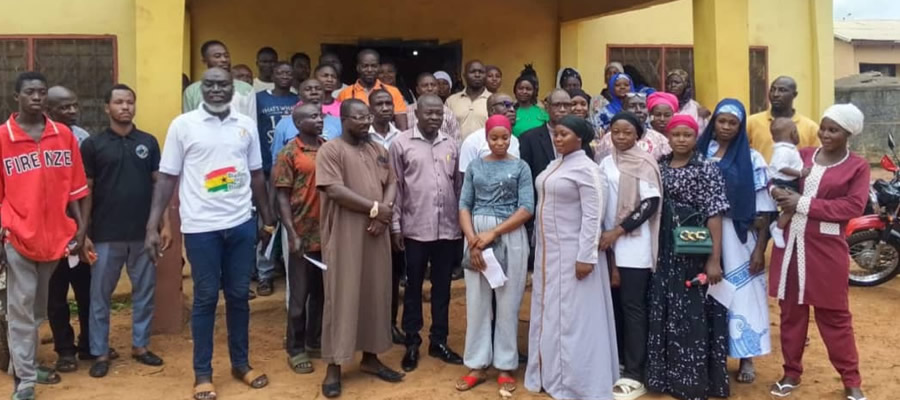

Dialects
There are many ethnic groups in the district. However, the major ethnic groups are the Mamprusis who speak mampruli, Bimoba whose dialect is muar and Konkombas who speak Likpakpa. These ethnic groups are mostly found in larger settlements. Minority groups found include Moshi, Talensi, and Hausa,
Religion
The district is prominently Islam. There are however, a number of Christians and Traditional Religion worshippers in the district.
Traditional Setup
With the traditional set up there is the Mamprugu Traditional Council which runs the affairs of the Mamprugu traditional area. 8km east of Gambaga is the seat of the Nayiri - Paramount Chief of Mamprugu.
Principal Towns
The four principal towns in the District are: Gambaga, Nalerigu, Langbensi and Gbintiri.
Tourism Attractions
The potential for tourism is very high in the district. The history of the district, its geographical location and the diverse ethnic composition of the people of the district enhance its potentials as a tourist destination.
Historically, the township of Nalerigu is important because of the role the settlement played as the traditional capital of the Mamprusi Kindgom and Gambaga as the capital of the Northern Territory from 1902 to 1957.
The rich cultures of the ethnic groups, especially the music and dance of the Konkombas, the Mamprusi and Bimobas as well as their festival and other ceremonies are unique and beautiful. There are specific tourist attractions as well that combine an acute sense of history, with the sheer beauty of nature. The Naa Jeringa Wall is a remnant of the historical wall built by one of the past Kings of the Mamprugu State.
There are plans to develop the site around the wall and the nearby dam with crocodiles, as well as Naa Jatinga’s grave located in the Nalerigu town. Structures will be put up at the site where well trained guards will be stationed. Visitors to the site will have an insight into the history, cultural and traditional practices peculiar to the Mamprusis.
The Nakpanduri Scarp and Waterfalls is a scene of immeasurable beauty, which is appreciated by each and every tourist who sees it, twenty-two miles from Gambaga, the district capital, and the whole stretch of the Scarp, with its wonderful waterfalls during the rainy season is a beautiful natural scene to watch. Already, the District Assembly has put together plans to develop the Nakpanduri Scarp and Waterfalls.
These include the protection of the area around the Scarp from the yearly bush burning and subsequent erosion. Also, a tourist village is to be developed on the Scarp with structures built with local materials and a beautiful garden of flowers. East Mamprusi Municipal is one that is eagerly awaiting an inflow of investment funds that can be used to fully utilize the natural resources and optimally exploit the potentials that are so abundant in the district.
The Ancient Wall of Nalerigu
The paramount chief of the Mamprusi Traditional Area, who ordered the wall to be built, was NAA-DZARINGA.This chief had only one son. Unfortunately for him, the child was blind in one eye, and according to tribal custom of the area, ka person with any bodily defect cannot occupy the royal stool. The child therefore could not succeed his father as paramount chief of the Mamprusi people.
The chief DZARINGA thought of how to raise a monument to his memory after his death. He struck on the idea of building a thick wall around the entire town of Nalerigu. He contacted his elders and councillors on the idea. He put it to them thus, “You are aware that my predecessor NAA-ATABIYA won many battles and conquered many tribes. I, DZARINGA, like-wise defeated many of our enemies’ towns and villages. I know for certain that we have many enemies around us who would want to revenge their defeat and regain their freedom. It is therefore adviceable that we build a thick wall around our capital seat, NALERIGU, so that any time we are attacked, it would serve as a protective point to defend ourselves against them”.
The elders and councillors readily accepted the proposal as good. Plans were therefore readily made and he ordered that his subjects amongst the surrounding tribes, captives and slaves should be summoned to work on the wall. They organised them into groups. East group worked for a short period in turns.
The following tribes worked to build the wall
The wall is known in Mamprusi dialect as “BRENGONE”. The earth or soil used in building the wall was mixed with honey, shea-butter and milk only. No water was used. The wall was initially about 6ft. thick at the base and its height was more than 10ft. it is that when ever a worker complained of tiredness or being sick he was considered to be lazy or malingering. Such persons were ordered to be bound up and covered or buried into the wall to help raise up the structure.
There were very strong gates built into the wall. They were guarded by soldiers day and night. The gates were opened only from dawn to sunset. Heights on parts of the wall still stand 6ft 5 inches-8ft.
The site from where the earth was dug out for the wall became a big ditch and developed into a stream known as BLIMI. A Wall is built across it forming a dam. It is now a source of good water supply to the town.
NAA-ATABIYA reigned from 1760 to 1775 and NAA-DZARINGA reigned from 1775 to 1785 (16years).
Date Created : 11/18/2017 4:10:51 AM









 facebook
facebook
 twitter
twitter
 Youtube
Youtube
 +233 593 831 280
+233 593 831 280 0800 430 430
0800 430 430 GPS: GE-231-4383
GPS: GE-231-4383 info@ghanadistricts.com
info@ghanadistricts.com Box GP1044, Accra, Ghana
Box GP1044, Accra, Ghana